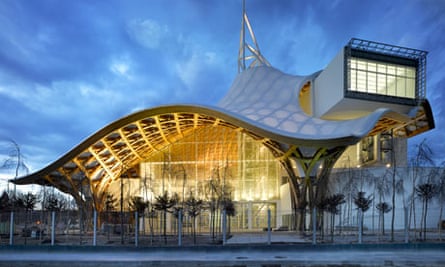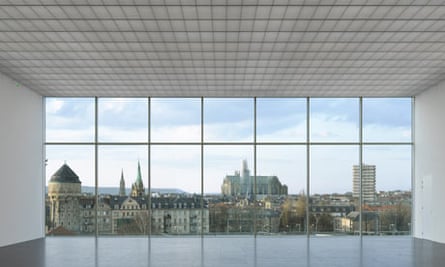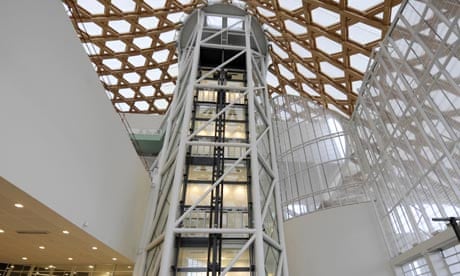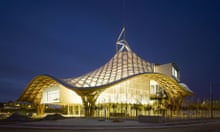This is a very strange fish. What first strikes the eye about the Pompidou-Metz is its bizarre, undulating roof. This complex structure, made of no fewer than 10 miles of laminated spruce and larch, is an extraordinary creation, drooping over the concrete, steel and glass core of the building in a seemingly random fashion, as if a passing bird had dropped a giant floppy hat on its head.
Coated in fibreglass, the roof has been shaped as much for practical reasons as for aesthetic ones – to keep sun, rain and snow at bay. It is, I can't help thinking, the building's best and most redeeming feature. Up close and on the inside, concrete, steel and glass take over, while every glance upwards allows another view of this glorious timber form.
The Pompidou Centre in Paris, opened in 1977, is one of the most visited art galleries in the world. So it makes perfect sense that it should choose to expand – creating this regional outpost in Metz, north-east France, a short, sensationally fast (1hr 25mins) TGV ride away from the capital. The Pompidou-Metz, rising up as if from the ocean like a great conch, was meant to open three years ago, but such experimental architecture rarely goes exactly to plan, and I suspect that roof might be to blame. It is now seven years since the design contest was won by a team comprising Shigeru Ban (Tokyo), Jean de Gastines (Paris) and Philip Gumuchdjian (London). Their curious new building, due to open next month, is just two minutes walk from the town's magnificent central station, designed like a castle by German architect Jürgen Kröger in the early 1900s.

Just as the original Pompidou was designed to reinvent a large area of central Paris, so the Pompidou-Metz forms the centrepiece of the city's amphitheatre quarter, a district formerly given over to industry. It is, by any standards, an important building: much cultural pride rides on its curving shoulders, locally and nationally. And for Metz, a city not on the regular tourist beat, here is a chance to reinvent itself.
So does the new gallery pull it off? Beneath that hat, the building at first feels all over the place, its galleries, cafes and intervening public spaces rushing off in all directions. Fishier and fishier. Yet some sort of logic does start to emerge. You enter a lobby, with the usual cafe, bookshop and so on, before entering the forum, a soaring space for displaying large-scale installations (since the advent of Tate Modern's Turbine Hall, every gallery needs one). Above and through this vast space, three huge concrete tubes crisscross, with windows at either end. These are the three principal galleries, reached by stairs or lift in the central 77-metre tall tower, which stands like the mast on a ship, skewering your attention. Each space has been carefully crafted to offer framed views of the city's monuments, including Kröger's fairytale station.
What curious galleries these are: concrete corridors in the air relying, to a great degree, on artificial lighting in an era when it has become commonplace for galleries to demand diffused daylight everywhere. Ban points out the advantages: these galleries are entirely free of columns, or any other interruption, so offer seamless spaces for showcasing art. In any case, this is meant to be as radical a building as the original Pompidou, which stunned the world with its own big idea: wearing its insides outside, it looked for all the world like a brightly painted North Sea oil rig.
The architects were well aware of the extraordinary story of Metz itself when putting their design together. Perilously close to the border with Germany, Metz has changed hands many times. This sense of flux invades the fabric of this new building – in the sense that nothing is wholly certain here and anything, culturally, can happen. Even the funding reflects this flux: although fundamentally a French project, the €69m (£61m) Pompidou-Metz has also been funded by the EU.
Five centuries of masterpieces
Its tall tower leads up to a rooftop cafe-restaurant, a viewing gallery, and a studio intended for live performances, particularly of an experimental type. From up here, the building looks and feels more like the big top of a circus, with views out to new landscaped gardens planted with cherry trees. Throughout, though, this is a strange and ambivalent building. It has the feeling of being a book of bits rather than a considered, tightly edited volume. This may be the point: such spatial oddity and aesthetic uncertainty goes, I think, to the heart of the Pompidou-Metz project. The idea here is that anything might go – that art, architecture and curatorship is an adventure rather than an ordained or highly governed experience.
Like its predecessor, the Pompidou-Metz will take some getting used to. Much, of course, turns on the quality and variety of what goes on show; the first major exhibition will be an ambitious attempt to find out what makes a masterpiece by displaying 800 art works drawn from the past five centuries. What is for sure, though, is that the gallery is not some opportunistic franchise, there to cash in on the Pompidou name, but an art centre in its own right, intended to have an identity very much its own.

Although the product of team work, the design bears many of the hallmarks of Ban, an American-educated Japanese architect celebrated for his work with unexpected materials: houses made from recycled paper tubes, a museum made from 156 shipping containers. Ban has the knack of conjuring inventive buildings from very little. The Pompidou-Metz, and certainly its roof, is very much his kind of structure.
Ban describes it as a "crustacean". When I look back at this provocative new building from the gaping mouth of Metz-Ville station, sunlight flashes off its roof, making it vanish for a moment – as if it had slid back into some primordial sea.
From Venice to Vegas: Other gallery outposts
The idea of creating branches of established museums is not a new one. In 1969, Peggy Guggenheim handed the collections in her Venetian palazzo to her uncle Solomon, making it a European outpost of his famous Frank Lloyd Wright-designed museum in New York. London's Tate opened its first regional outpost, Tate Liverpool, in 1988, in a magnificent warehouse given a makeover by James Stirling. Tate St Ives, designed by Evans and Shalev, followed five years later.
The Peggy Guggenheim Collection in Venice and the regional Tates are all galleries with their own special characters, collections and displays; it would be unfair to call any of them clones. But what has changed in recent years is the idea of the museum or gallery "franchise": a branch of the Guggenheim, Louvre or Hermitage borrowing shows, most of its ideas and content, and, most importantly, its name from a parent institution.
Since the 1990s, the Guggenheim has opened new branches around the world, even in Las Vegas (a failure: it closed in 2003). Las Vegas was also host to the hybrid Guggenheim Hermitage Museum, which closed in 2008. Frank Gehry designed the eye-popping branch in Bilbao, while future Guggenheims are under construction in Guadalajara, Mexico (due to open in 2011) and Abu Dhabi (Frank Gehry again, 2011). The first major Louvre branch, a giant mushroom designed by Jean Nouvel (below), is taking shape in Abu Dhabi for 2012. In London, the Victoria and Albert museum is preparing to venture beyond the confines of South Kensington: the first V&A "abroad" will be built in Dundee, Scotland.
In architectural terms, the danger is that these can be expensive, over-the-top projects, parachuted into far-off countries without the subtlety that comes from architects working within the confines and discipline of cities they know well. Given carte blanche, there is a tendency to design something a little too wilful or impermanent.



